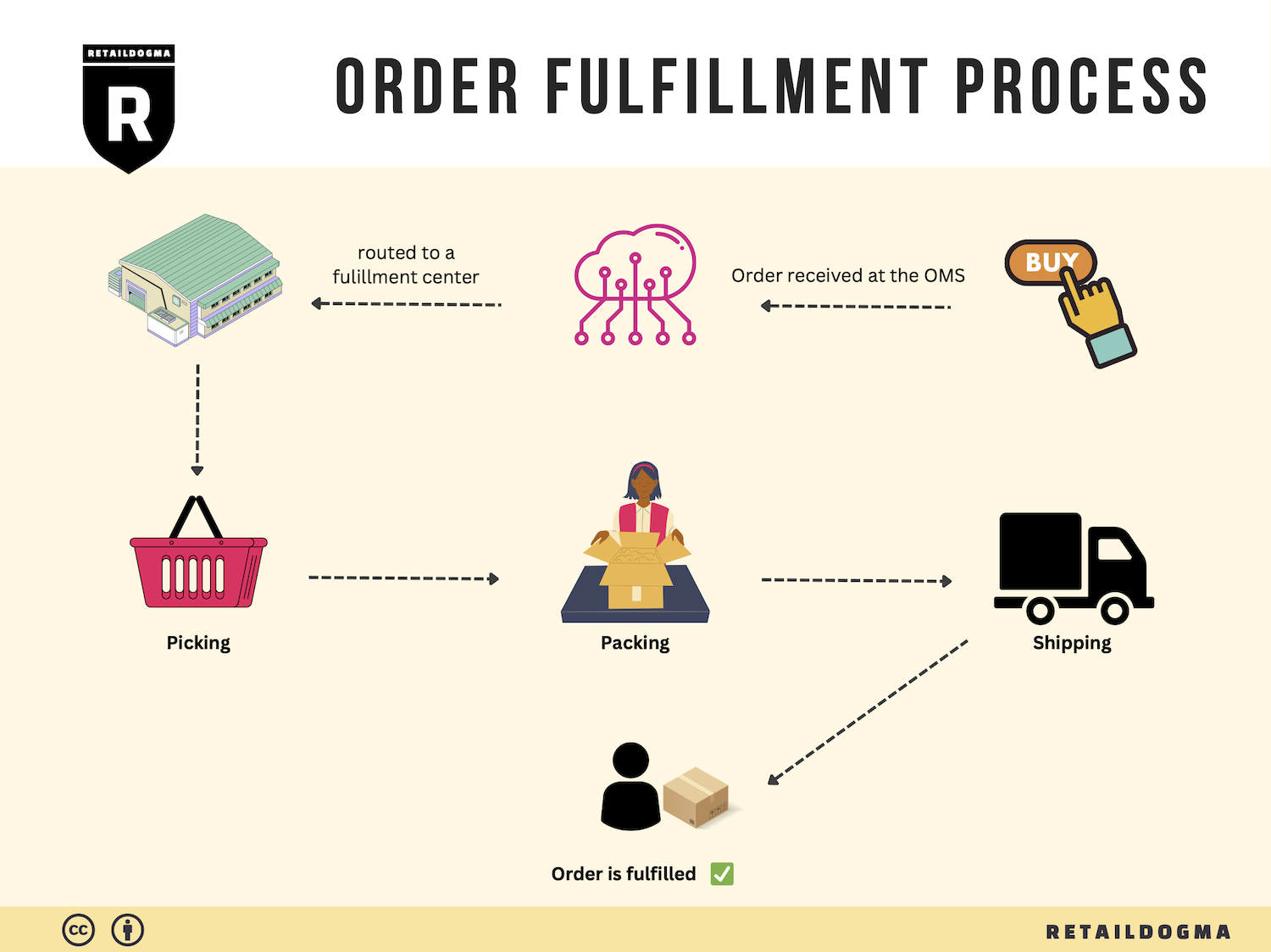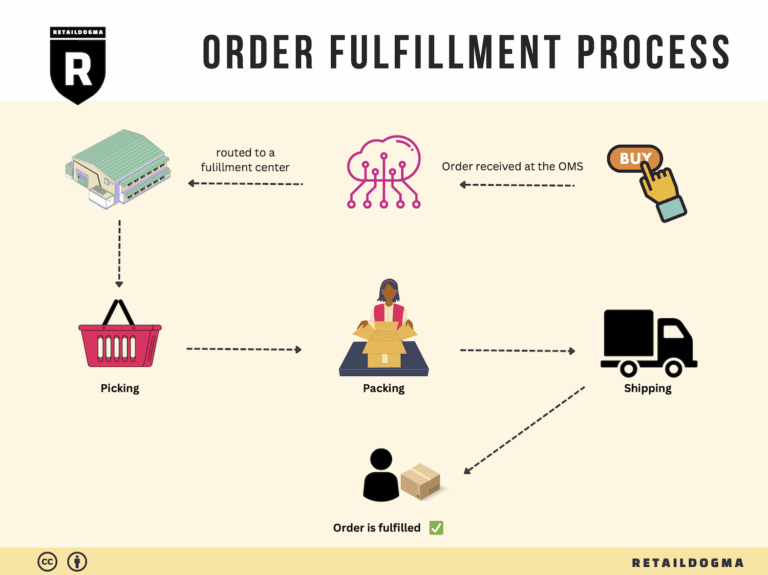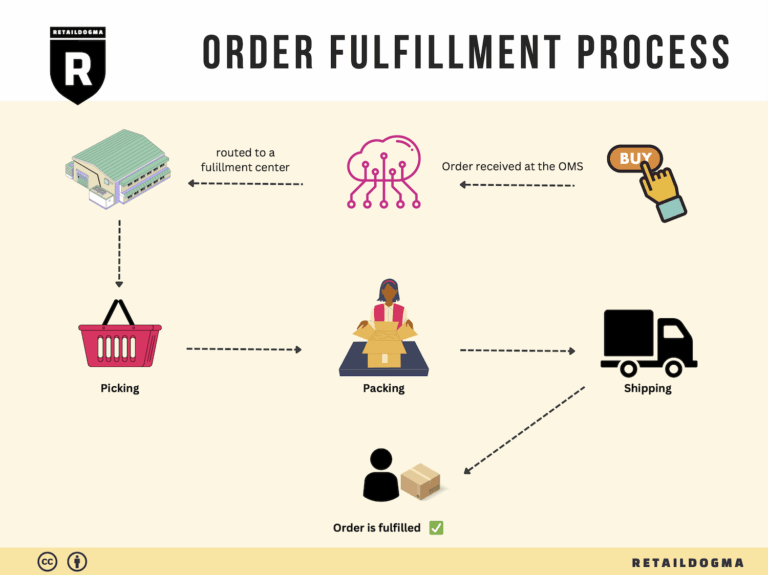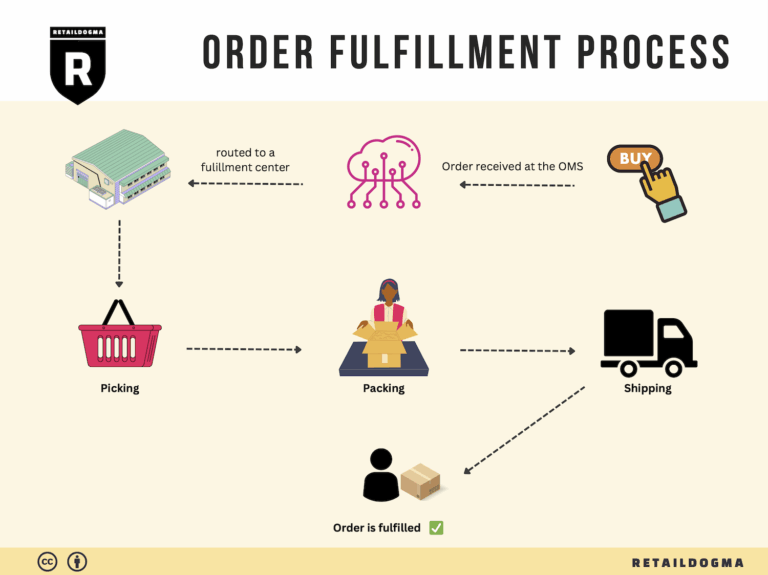How Order Fulfillment Works: A Step-by-Step Guide for Businesses
What is E-commerce Fulfillment? An Introduction for Growing Businesses
The Challenge of Order Fulfillment for Growing Businesses
For many e-commerce entrepreneurs, the excitement of growing sales can quickly turn into a logistical nightmare. As orders begin to surge, managing the packing and shipping of products can become overwhelming. The complexities of inventory management, timely deliveries, and customer expectations can create a perfect storm of operational challenges. This is where effective e-commerce fulfillment becomes crucial.
Fulfillment is simply the process of getting a product from your online store into the hands of your customer. It encompasses everything from receiving an order, picking and packing the items, and shipping them out, to managing returns and customer service inquiries. As businesses scale, the intricacies of fulfillment can significantly affect profitability, customer satisfaction, and overall business growth.
What This Guide Will Cover
In this comprehensive guide, we will explore various fulfillment models that can help streamline your operations. We’ll delve into options like Third-Party Logistics (3PL) and Fulfillment by Amazon (FBA), examining the advantages and potential drawbacks of each. Understanding these models is essential for identifying which aligns best with your business needs.
Additionally, we will discuss the core services offered by fulfillment partners, including inventory management, order processing, and shipping logistics. Knowing what services are available will empower you to select a partner that can support your growth effectively.
Choosing the right fulfillment partner is a critical decision for any growing business. We’ll provide practical insights into what to consider when evaluating potential partners, including their technology capabilities, scalability, and customer service track record.
Lastly, we will break down the various pricing structures associated with fulfillment services, helping you understand how to budget for these essential operations without compromising on quality.
Empowering Smart Logistics Decisions
The ultimate goal of this guide is to empower your business to make informed and strategic decisions about your logistics. By understanding the nuances of e-commerce fulfillment and exploring the options available, you can optimize your operations, enhance customer satisfaction, and focus on what you do best—growing your business. With the right fulfillment strategy in place, you can transform logistics from a pain point into a competitive advantage.

What You’ll Learn In This Guide
- What is E-commerce Fulfillment? An Introduction for Growing Businesses
- The Order Fulfillment Process: From ‘Buy’ Button to Customer’s Door
- Comparing Fulfillment Models: In-House vs. 3PL vs. Dropshipping
- A Deep Dive into Amazon FBA: Pros, Cons, and Who It’s For
- Core Services Offered by Fulfillment Centers
- How to Choose a Fulfillment Partner: A 6-Point Checklist
- Understanding Fulfillment Pricing: A Breakdown of Common Fees
- Frequently Asked Questions (FAQs) about Fulfillment
- Conclusion: Is Outsourcing Fulfillment the Right Move for Your Business?
- Important Disclaimer
The Order Fulfillment Process: From ‘Buy’ Button to Customer’s Door
1. Receiving Inventory
The first step in the order fulfillment process begins with receiving inventory. When products arrive at your warehouse, they are checked against purchase orders to ensure accuracy in quantity and quality. This involves inspecting items for damage and verifying that the correct products have been delivered.
Importance: Accurate receiving is crucial because it sets the foundation for all subsequent operations. If discrepancies occur at this stage, it can lead to inventory shortages, which directly impacts order fulfillment rates. Efficient receiving ensures that your stock levels are accurate, which is essential for maintaining customer satisfaction and avoiding stockouts.
Key Term: SKU (Stock Keeping Unit) – This unique identifier helps in tracking inventory items accurately. Each SKU corresponds to a specific product variant, allowing for easy management and retrieval during the fulfillment process.
2. Warehouse Storage
Once the inventory has been received and verified, it is then organized within the warehouse. This involves determining the optimal storage locations based on product type, size, and demand. Products may be stored on shelves, pallets, or bins, and it’s crucial to maintain an organized layout to facilitate efficient retrieval.
Importance: Effective warehouse storage maximizes space utilization and minimizes the time it takes to locate and pick products. An organized warehouse reduces the likelihood of errors and increases productivity, which is especially important as order volumes rise.
Key Term: ABC Analysis – This inventory categorization technique helps prioritize stock based on importance and turnover rate. A-items are high-value products with low sales frequency, while C-items are low-value with high sales frequency. Proper categorization aids in efficient storage and retrieval.
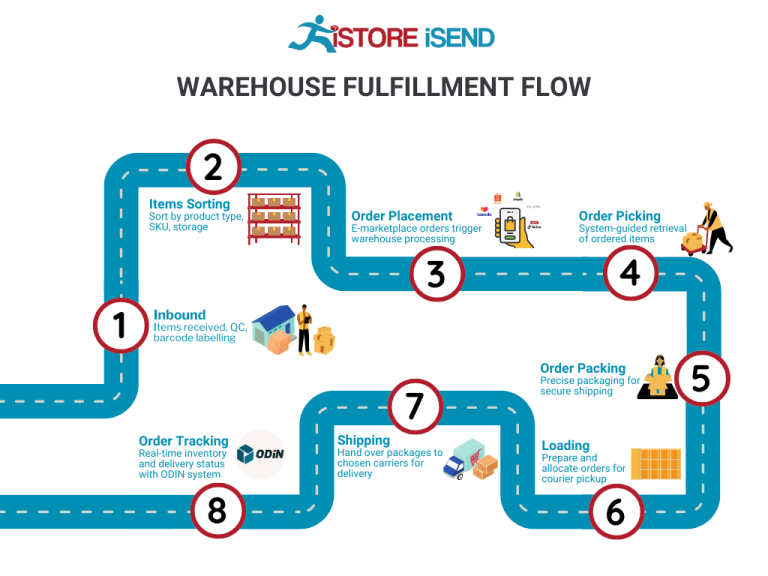
3. Order Picking
With inventory stored and organized, the next step is order picking. This involves selecting the correct items from the warehouse to fulfill customer orders. Warehouse staff typically use pick lists generated by the order management system, which detail the items needed for each order.
Importance: Accurate picking is vital to ensuring that customers receive the correct products. Mistakes in this step can lead to returns, dissatisfaction, and increased operational costs. Efficient picking processes also help reduce the time from order placement to shipping, which is a significant factor in customer satisfaction.
Key Term: Pick List – This document or digital tool outlines the items needed for each order, including quantities and locations. Using a pick list streamlines the picking process and reduces the chance of errors.
4. Order Packing
After items have been picked, they are moved to the packing station. Here, products are carefully packaged for shipment. This includes selecting appropriate packing materials, ensuring that items are protected during transit, and labeling packages with shipping information.
Importance: Proper packing is essential to prevent damage during shipping and to ensure compliance with shipping regulations. Additionally, well-packed orders enhance the customer experience, as they reflect professionalism and care in handling.
Key Term: Packing Slip – This document is included in the package and outlines the items enclosed. It serves as a receipt for the customer and helps in verifying that the correct items were shipped.
5. Shipping & Delivery
The final step in the order fulfillment process is shipping and delivery. Once packages are packed, they are labeled and handed over to a carrier for transport. This phase includes choosing the right shipping method based on factors such as cost, speed, and destination.
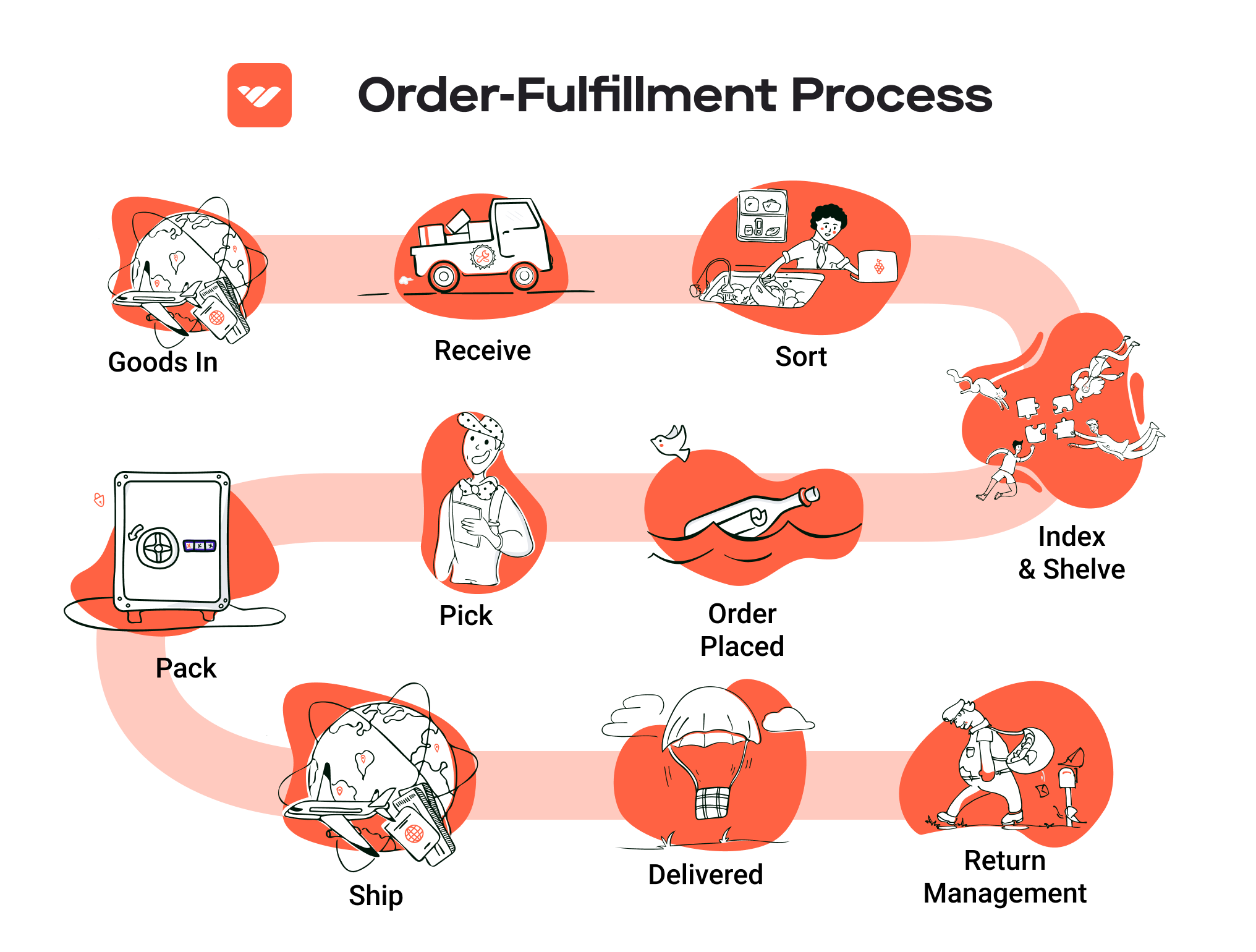
Importance: Timely shipping is critical for customer satisfaction. Delays in this stage can lead to negative experiences and lost sales opportunities. Effective communication regarding shipping status also plays a role in maintaining customer trust and transparency.
Key Term: Tracking Number – This unique identifier allows customers to monitor the progress of their shipment. Providing tracking information enhances customer satisfaction by keeping them informed about their order’s status and expected delivery time.
In summary, the order fulfillment process is a complex yet essential component of e-commerce operations. Each step, from receiving inventory to shipping and delivery, plays a critical role in ensuring that customers receive their orders accurately and on time. By understanding and optimizing each phase, businesses can significantly enhance their operational efficiency and customer satisfaction.
Comparing Fulfillment Models: In-House vs. 3PL vs. Dropshipping
Fulfillment Model Comparison
| Model | Who Handles Inventory | Best For (Business Stage) | Key Advantage | Key Disadvantage |
|---|---|---|---|---|
| In-House Fulfillment | The business itself | Startups and small businesses | Complete control over inventory and processes | High overhead costs and resource demands |
| Third-Party Logistics (3PL) | 3PL provider | Growing and scaling businesses | Expertise in logistics and scalability | Less control over the fulfillment process |
| Dropshipping | Supplier or manufacturer | New and low-capital businesses | Low upfront investment and minimal risk | Lower profit margins and dependency on suppliers |
In-House Fulfillment
In-house fulfillment refers to the process where businesses manage their own warehousing, inventory management, and order processing. This model is particularly favored by startups and small businesses that wish to maintain complete control over their logistics operations. One of the significant advantages of in-house fulfillment is the ability to oversee every aspect of the process, from inventory management to shipping. This control allows businesses to implement personalized packaging, branding, and customer service strategies that can enhance the overall customer experience. However, the drawbacks are notable; businesses must invest heavily in infrastructure, including warehouse space, technology, and personnel, which can lead to high overhead costs. Additionally, as demand fluctuates, scaling up operations can be labor-intensive and financially taxing, making this model less flexible in the face of rapid growth or seasonal spikes.
Third-Party Logistics (3PL)
Third-party logistics providers specialize in managing the logistics and fulfillment processes for businesses. This model is ideal for growing and scaling businesses that require expertise in logistics without the burden of managing it themselves. Partnering with a 3PL allows businesses to leverage the provider’s infrastructure, technology, and industry knowledge, which can significantly streamline operations. A key advantage of using a 3PL is the scalability it offers; businesses can easily adjust their logistics capabilities to meet changing demand without needing to invest in additional resources. Moreover, 3PLs often benefit from economies of scale, which can lead to reduced shipping costs and improved delivery times. However, one of the main disadvantages is the loss of direct control over the fulfillment process. This can lead to potential misalignments in brand representation, customer service, and order handling, which can impact customer satisfaction if not managed effectively.
Dropshipping
Dropshipping is a fulfillment model where the retailer does not keep products in stock but instead transfers customer orders and shipment details to a supplier or manufacturer, who then ships the products directly to the customer. This model is particularly well-suited for new businesses or those with limited capital, as it eliminates the need for inventory investment and reduces the financial risk associated with unsold stock. The primary advantage of dropshipping is the low barrier to entry; entrepreneurs can start an e-commerce business with minimal upfront costs and operational complexity. However, dropshipping also comes with significant challenges. Profit margins tend to be lower compared to other fulfillment models because the retailer must pay the supplier’s price, which may not leave much room for markup. Additionally, retailers are dependent on their suppliers for inventory and shipping, which can lead to issues with stock availability, shipping delays, and quality control—factors that can negatively impact customer satisfaction and brand reputation.
Conclusion
Choosing the right fulfillment model is crucial for e-commerce businesses aiming to scale effectively. Each model—In-House Fulfillment, Third-Party Logistics, and Dropshipping—offers unique benefits and challenges that should be carefully considered based on the specific needs and stage of the business. In-house fulfillment provides control and customization but comes with high overhead costs. Third-party logistics offer expertise and scalability but can result in less direct oversight. Dropshipping presents a low-risk entry point but often leads to lower profit margins and reliance on suppliers. Understanding these dynamics will empower business owners to make informed decisions that align with their growth strategies and operational capabilities.
A Deep Dive into Amazon FBA: Pros, Cons, and Who It’s For
Understanding Fulfillment by Amazon (FBA)
Fulfillment by Amazon (FBA) is a service provided by Amazon that allows e-commerce sellers to store their products in Amazon’s fulfillment centers. Amazon then takes care of storage, packaging, and shipping of the products on behalf of the sellers. This service enables sellers to leverage Amazon’s extensive logistics network, allowing them to focus on growing their businesses while Amazon manages the complexities of order fulfillment.
How FBA Works
The FBA process begins with sellers sending their inventory to Amazon’s warehouses. Once the products are received, they are stored in Amazon’s fulfillment centers. When a customer places an order for a product, Amazon handles the entire fulfillment process, including:
- Order Processing: As soon as an order is placed, Amazon’s system automatically picks the product from the inventory.
- Packaging: The product is packaged using Amazon’s materials, ensuring it meets their quality standards.
- Shipping: Amazon ships the product directly to the customer, often with expedited shipping options such as Amazon Prime.
- Customer Service and Returns: Amazon also manages customer service inquiries and return processing, providing a seamless experience for both the seller and the buyer.
By utilizing FBA, sellers can take advantage of Amazon’s vast customer base and sophisticated logistics capabilities, positioning their products for greater visibility and sales potential.
Pros of Using Amazon FBA
1. Prime Eligibility
One of the most significant advantages of using FBA is the eligibility for Amazon Prime. Products fulfilled by Amazon are often labeled with the Prime badge, making them more attractive to millions of Prime members who prefer fast, free shipping. This can significantly boost sales, as Prime members tend to spend more on products that offer this shipping option.
2. Enhanced Customer Trust
Amazon is a trusted name in e-commerce, and customers often feel more confident purchasing products fulfilled by Amazon. The assurance of reliable shipping, easy returns, and customer service through Amazon enhances the credibility of the seller’s products, which can lead to higher conversion rates.
3. Multi-Channel Fulfillment
FBA isn’t limited to just sales on Amazon. Sellers can utilize FBA for multi-channel fulfillment, meaning they can sell their products on other platforms like eBay, their own websites, or through social media. Amazon will still handle the storage, shipping, and customer service for these orders, making it a versatile option for sellers looking to expand their reach.
4. Scalability
With FBA, businesses can scale quickly without the need to invest heavily in logistics infrastructure. As demand for products increases, sellers can simply send more inventory to Amazon’s warehouses without worrying about fulfillment complexities. This allows for rapid growth and adaptation to market changes.
5. Time Savings
By outsourcing fulfillment to Amazon, sellers can save significant time and resources. This enables them to focus on other critical areas of their business, such as marketing, product development, and customer engagement, rather than logistics and order processing.
Cons of Using Amazon FBA
1. High Fees
While FBA offers many benefits, it comes with costs that can eat into profit margins. Sellers must pay storage fees for their inventory as well as fulfillment fees for each order processed. These costs can add up, especially for low-margin products or if inventory turnover is slow.
2. Strict Inventory Rules
Amazon has strict guidelines and rules regarding inventory management. Sellers must adhere to these policies, including maintaining certain levels of inventory and ensuring that products meet Amazon’s quality standards. Failure to comply can result in additional fees or even account suspension.
3. Commingling Risks
When products are commingled, Amazon pools inventory from multiple sellers. This means that when an order is placed, a product shipped may not be the exact item sent to the warehouse by the seller. This can pose risks for sellers, such as receiving negative feedback due to quality issues with products not originally sourced by them.
4. Limited Control Over Shipping
While Amazon handles shipping and customer service, sellers have limited control over how their products are packaged and shipped. This can lead to inconsistencies in branding and customer experience, which may not align with the seller’s vision.
5. Dependency on Amazon
Utilizing FBA creates a dependency on Amazon’s ecosystem. Sellers must comply with Amazon’s policies and changes, which can sometimes be unpredictable. This reliance can pose risks if Amazon changes its fee structure, policies, or algorithms that affect product visibility.
Who is FBA Best For?
Fulfillment by Amazon is particularly well-suited for:
- Small to Medium-Sized Businesses: Sellers looking to scale quickly without investing heavily in logistics can benefit from FBA’s streamlined processes.
- E-commerce Entrepreneurs: Individuals starting their online businesses can leverage Amazon’s infrastructure to minimize the complexities associated with fulfillment.
- Brands Seeking Visibility: Businesses that want to reach a larger audience and increase their sales through Amazon’s platform can find FBA advantageous, especially for products that are suitable for Prime members.
- Multi-Channel Sellers: Companies that sell across various platforms and want a consistent fulfillment process can utilize FBA to manage orders from multiple sources efficiently.
In conclusion, while FBA presents numerous advantages in terms of logistics, customer trust, and scalability, it’s essential for sellers to carefully consider the associated costs and operational implications. By weighing the pros and cons, e-commerce business owners can make informed decisions about whether Amazon FBA aligns with their growth strategies and operational capabilities.
Core Services Offered by Fulfillment Centers
Inventory Management & Warehousing
Inventory management and warehousing are foundational services provided by fulfillment centers that directly impact the efficiency of your e-commerce operations. This service involves the systematic tracking and storage of your products in a warehouse, ensuring that stock levels are optimized and accurately reflected in your inventory management system.
What It Is: Fulfillment centers utilize advanced inventory management systems to monitor stock levels, manage reorder points, and track the movement of goods. They handle receiving shipments, storing products in a well-organized manner, and conducting regular audits to maintain accuracy.
Benefits to E-Commerce Businesses:
– Reduced Stockouts and Overstocks: By effectively managing inventory, fulfillment centers help prevent stockouts, which can lead to lost sales, and overstocks, which can tie up cash flow.
– Increased Efficiency: With streamlined inventory processes, businesses can reduce the time spent on inventory-related tasks, allowing them to focus on sales and customer engagement.
– Data-Driven Decisions: Access to real-time inventory data enables businesses to make informed decisions regarding purchasing, promotions, and product launches.
Pick and Pack Services
Pick and pack services are crucial for fulfilling customer orders accurately and efficiently. This service involves selecting items from inventory (picking) and preparing them for shipment (packing) according to specific order requirements.
What It Is: When an order is placed, fulfillment center staff retrieve the ordered items from the warehouse shelves and pack them securely for shipping. This process may include choosing appropriate packaging materials, including packing slips, and ensuring that items are protected during transit.
Benefits to E-Commerce Businesses:
– Accuracy and Speed: Professional pick and pack services minimize errors in order fulfillment, ensuring that customers receive exactly what they ordered. This leads to faster processing times, enhancing overall customer satisfaction.
– Scalability: As your business grows, fulfillment centers can easily scale pick and pack operations to handle increased order volumes without compromising on quality or speed.
– Cost Efficiency: Outsourcing these services can reduce labor costs associated with in-house fulfillment, as fulfillment centers have established processes and trained personnel to handle order fulfillment efficiently.
Kitting and Assembly
Kitting and assembly services offered by fulfillment centers allow businesses to streamline their product offerings by combining multiple items into a single package or assembling products before shipping.
What It Is: This service involves grouping individual items together to create a kit or assembling components into a finished product. For example, a fulfillment center might package a set of items together as a gift set or assemble parts of a product that need to be sold as a complete unit.
Benefits to E-Commerce Businesses:
– Enhanced Product Offerings: Kitting allows businesses to create unique product bundles or kits that can be marketed as special offers, increasing the average order value.
– Efficiency in Fulfillment: By preparing kits or assembled products in advance, fulfillment centers can reduce the time it takes to fulfill orders, leading to quicker shipping times.
– Inventory Optimization: Kitting can help manage inventory levels more effectively, as businesses can sell bundled products rather than individual items, reducing the risk of overstock on less popular SKUs.
Returns Management (Reverse Logistics)
Returns management, or reverse logistics, is an essential service that handles the process of returns, exchanges, and product recalls. It ensures that returned items are processed efficiently and that customers have a positive experience, even when they need to return a product.
What It Is: Fulfillment centers manage the entire returns process, from providing customers with return labels to inspecting returned items and restocking them in inventory. They also handle the necessary paperwork and update inventory systems accordingly.
Benefits to E-Commerce Businesses:
– Improved Customer Satisfaction: A smooth returns process enhances customer trust and loyalty, as customers feel confident that they can return items if they are not satisfied.
– Operational Efficiency: By outsourcing returns management, businesses can free up resources that would otherwise be spent on handling returns in-house, allowing them to focus on core business functions.
– Data Insights: Fulfillment centers can provide valuable data on return reasons, which can help businesses identify product issues, improve quality, and refine marketing strategies.
In conclusion, partnering with a fulfillment center for these core services can significantly enhance the operational capabilities of an e-commerce business. By leveraging their expertise in inventory management, pick and pack, kitting, and returns management, businesses can streamline their logistics processes, improve customer satisfaction, and ultimately drive growth.
How to Choose a Fulfillment Partner: A 6-Point Checklist
Location & Warehouse Network
Importance:
The geographical location of your fulfillment partner’s warehouses can significantly impact shipping times and costs. A partner with strategically located facilities can help you reach customers faster and reduce shipping expenses.
Questions to Ask:
– Where are your warehouses located, and how many do you operate?
– How do your locations align with my target customer demographics?
– Can you provide details on shipping times and costs for various regions?
– Do you have a plan for expanding your warehouse network as my business grows?
Technology & Integrations
Importance:
In today’s digital landscape, seamless technology integration is vital for efficient order processing and inventory management. A partner with robust technology can provide real-time tracking, automated updates, and detailed analytics, ensuring you stay informed about your fulfillment operations.
Questions to Ask:
– What technology platforms do you use for order management, inventory tracking, and customer communication?
– Can your systems integrate with my existing e-commerce platform and other software tools?
– How do you ensure data security and compliance with regulations?
– Do you offer real-time reporting and analytics? If so, what kind of data can I access?
Specializations (e.g., cold storage, oversized items)
Importance:
Your products may require specific handling, storage conditions, or special services. Choosing a partner with the right specializations can prevent damage, ensure compliance, and enhance customer satisfaction.
Questions to Ask:
– Do you have experience handling products similar to mine? (e.g., perishables, fragile items, oversized products)
– What special storage or handling capabilities do you offer?
– Are your facilities equipped for temperature-controlled storage if needed?
– Can you provide examples of how you’ve successfully fulfilled similar product types?
Scalability & Capacity
Importance:
As your business grows, your fulfillment needs may change. A suitable partner should be able to scale operations to meet your demands without compromising service quality. Flexibility in capacity can help you manage seasonal spikes and unexpected growth effectively.
Questions to Ask:
– How do you handle increased order volumes, especially during peak seasons?
– What are your capabilities for scaling operations up or down?
– Are there limits to your capacity that I should be aware of?
– How quickly can you accommodate changes in our fulfillment requirements?
Pricing and Contracts
Importance:
Understanding pricing structures and contract terms is crucial to ensure that you’re getting value for your investment. Transparency in pricing helps you avoid unexpected fees and allows for better financial planning.
Questions to Ask:
– What is your pricing model (e.g., per order, per item, flat fee)?
– Are there any additional fees (e.g., setup, storage, returns)?
– Can you provide a detailed breakdown of costs?
– What are the terms of the contract, including cancellation policies and notice periods?
Customer Support & Reviews
Importance:
Effective customer support is essential for addressing issues and ensuring smooth operations. Researching reviews and testimonials can provide insights into the partner’s reliability and service quality.
Questions to Ask:
– What customer support channels do you offer (e.g., phone, email, chat)?
– What are your average response times for support inquiries?
– Can you provide references or case studies from current or past clients?
– How do you handle issues such as order errors, delays, or damaged products?
Conclusion
Choosing the right fulfillment partner is a critical decision that can impact your e-commerce business’s efficiency and customer satisfaction. By using this checklist, you can ensure that your potential partner aligns with your operational needs, growth plans, and customer expectations. Taking the time to ask the right questions will help you make an informed decision that supports your business’s long-term success.
Understanding Fulfillment Pricing: A Breakdown of Common Fees
Initial Setup Fees
Initial setup fees are one-time charges associated with onboarding a new fulfillment service provider. These fees can cover a range of services, including account creation, system integration, and setup of inventory management systems. The costs may vary significantly based on the complexity of your operations and the provider’s capabilities.
To calculate these fees, providers typically assess the following factors:
– Complexity of Integration: If your e-commerce platform requires a custom API integration, expect higher fees.
– Inventory Volume: The amount of stock you are bringing into the system can influence setup time and costs.
– Service Customization: Tailoring fulfillment services to meet specific business needs may incur additional charges.
Receiving Fees
Receiving fees are charged each time the fulfillment center accepts new inventory. This fee compensates the provider for the labor and resources required to unload, inspect, and log incoming goods into their inventory management system.
Calculations for receiving fees are generally based on:
– Volume of Goods: Fees may be charged per pallet, carton, or item, depending on how your inventory is received.
– Labor Time: If your products require additional handling, such as repackaging or quality checks, this may also impact the cost.
– Seasonality: During peak seasons, such as holidays, receiving fees may increase due to higher demand for labor and space.
Storage Fees (per pallet/bin)
Storage fees are recurring charges based on the space your inventory occupies in the fulfillment center. These fees are typically calculated on a monthly basis and can vary depending on whether you are using pallet storage or bin storage.
To determine storage fees, consider the following aspects:
– Space Utilization: Costs are often calculated per pallet or per bin, with a pallet typically accommodating larger quantities of goods.
– Duration of Storage: Longer storage times may result in higher cumulative fees, particularly if goods remain unsold for extended periods.
– Environmental Conditions: Specialized storage requirements, such as temperature control for perishables, can also lead to increased fees.
Pick & Pack Fees (per item/order)
Pick and pack fees are charged for the process of selecting items from inventory (picking) and preparing them for shipment (packing). This fee is critical to understand as it directly impacts your overall fulfillment costs.
These fees are generally calculated based on:
– Number of Items: A common model is to charge per item picked and packed. For example, if an order contains three items, you may incur three separate pick and pack fees.
– Order Complexity: More complex orders that require special packaging or additional handling may incur higher fees.
– Batch Orders: Some providers offer discounts for bulk or batch orders, so consolidating multiple orders could save on pick and pack costs.
Shipping Fees
Shipping fees are the costs associated with transporting your products from the fulfillment center to the customer. These fees can vary widely based on factors such as shipping method, destination, and weight of the package.
Key factors in calculating shipping fees include:
– Carrier Rates: Different carriers (e.g., UPS, FedEx, USPS) have varied pricing structures. Fulfillment centers may pass these rates directly to you or mark them up.
– Shipping Zones: Costs typically increase with distance. Shipping within local zones is generally cheaper than shipping across the country or internationally.
– Package Dimensions and Weight: Carriers often use dimensional weight pricing, so larger packages may incur higher fees even if they are lighter than standard packages.
Tips for Getting an Accurate Quote
-
Provide Detailed Information: When seeking quotes, offer comprehensive details about your inventory, including item dimensions, weight, and turnover rates. This transparency helps providers give a more accurate estimate.
-
Ask About Pricing Models: Inquire whether the fulfillment center uses flat-rate, tiered, or variable pricing. Understanding their pricing model will help you anticipate costs more accurately.
-
Negotiate Terms: If you expect a high volume of shipments, don’t hesitate to negotiate for better rates or discounts based on your projected growth.
-
Evaluate Additional Services: Consider what additional services (like returns processing, custom packaging, etc.) might be included in the quote and how they might affect your overall costs.
-
Request a Breakdown of Fees: Always ask for a detailed breakdown of all potential fees to avoid surprises later. This clarity will help you make informed decisions about your fulfillment strategy.
By understanding these common fulfillment pricing models and how they are calculated, you can better manage your operational costs and ensure your e-commerce business scales effectively.
Frequently Asked Questions (FAQs) about Fulfillment
1. What does “fulfillment status unfulfilled” mean?
The “fulfillment status unfulfilled” indicates that an order has been placed but none of the items have been shipped yet. This status suggests that the order is still in the processing stage, and the fulfillment center has not initiated the shipping process for any part of the order.
2. What causes an order to remain in the “unfulfilled” status?
Several factors can lead to an order being marked as unfulfilled, including stock shortages, payment verification issues, or administrative delays. Additionally, if an order is placed for a pre-order item that hasn’t yet been released, it will also remain unfulfilled until the item is available for shipping.
3. How can I check the status of my unfulfilled order?
You can typically check the status of your unfulfilled order by logging into your account on the e-commerce platform where you made the purchase. Most platforms provide real-time updates on order statuses, including unfulfilled orders. If you cannot find the information, contacting customer service can also provide clarity.
4. What should I do if my order has been unfulfilled for an extended period?
If your order has been unfulfilled for an unusually long time, first check the retailer’s website or your account for any updates. If there are no updates, reach out to customer service for assistance. They can provide insights into the cause of the delay and possible resolutions.
5. What is the difference between a warehouse and a fulfillment center?
A warehouse primarily focuses on storing inventory and may not handle the logistics of shipping orders directly to customers. In contrast, a fulfillment center is designed specifically for order processing and shipping, often providing services like picking, packing, and returns management, making it more integrated into the e-commerce supply chain.
6. What is a Third-Party Logistics (3PL) provider?
A Third-Party Logistics (3PL) provider is a company that offers outsourced logistics services, including warehousing, fulfillment, shipping, and inventory management. Partnering with a 3PL can help e-commerce businesses scale efficiently by handling complex logistics operations, allowing them to focus on core business functions.
7. How much do fulfillment services cost?
The cost of fulfillment services can vary widely based on factors such as the volume of orders, the complexity of the products being shipped, and the specific services required (e.g., storage, packing, shipping). Generally, fulfillment costs include storage fees, pick and pack fees, and shipping charges. It’s advisable to request quotes from multiple providers to compare costs and services.
8. Can I change my order status from unfulfilled to fulfilled manually?
Typically, customers cannot manually change an order status from unfulfilled to fulfilled, as this process is managed by the retailer or fulfillment center. If you need to expedite an unfulfilled order, you should contact the retailer’s customer service for assistance.
9. How does an unfulfilled order impact customer satisfaction?
An unfulfilled order can negatively impact customer satisfaction, as it may lead to frustration due to delays in receiving products. Clear communication from the retailer about the status of unfulfilled orders, including expected timelines and reasons for delays, is crucial to maintaining customer trust and satisfaction.
10. What steps can businesses take to minimize unfulfilled orders?
To minimize unfulfilled orders, businesses can implement several strategies, such as maintaining accurate inventory levels, improving forecasting methods, and establishing strong relationships with suppliers. Additionally, utilizing a robust order management system can help track orders in real time and identify potential issues before they affect fulfillment.
Conclusion: Is Outsourcing Fulfillment the Right Move for Your Business?
Evaluating the Benefits of Outsourcing Fulfillment
Outsourcing your fulfillment process can be a transformative decision for your e-commerce business. By partnering with a fulfillment service, you unlock several key advantages that can significantly enhance your operations and drive growth.
First and foremost, outsourcing saves you valuable time. With a dedicated fulfillment partner managing your logistics, you can redirect your focus toward core business activities such as product development and marketing. This shift allows you to innovate and expand your offerings without being bogged down by the complexities of order processing, inventory management, and shipping logistics.
Scalability is another critical benefit. As your business grows, so do your operational demands. A reputable fulfillment service provides the flexibility to scale your logistics operations up or down in response to market fluctuations and seasonal demands. This adaptability ensures that you can meet customer expectations without overextending your resources or infrastructure.
Moreover, tapping into the expertise of a fulfillment partner means you benefit from seasoned professionals who understand the intricacies of logistics. Their experience translates into fewer errors, faster shipping times, and improved overall efficiency. With access to advanced technology and industry best practices, your fulfillment partner can enhance your operational capabilities, resulting in a smoother customer experience.
However, it’s essential to choose the right fulfillment partner. The success of outsourcing hinges on finding a provider that aligns with your business goals and operational needs. Conduct a thorough audit of your current shipping process to identify pain points and assess whether a fulfillment service can offer the improvements you seek.
In conclusion, consider whether outsourcing fulfillment is the strategic next step for your business. By leveraging the benefits of time savings, scalability, and expertise, you can position your e-commerce venture for sustained growth and success. Take action today — evaluate your current processes and explore the potential of a fulfillment partnership to elevate your business to new heights.
Important Disclaimer
⚠️ Important Disclaimer
The information in this guide is for educational purposes. Fulfillment services, pricing, and platform features change frequently. Always conduct your own due diligence and consult with providers directly before making business decisions.
